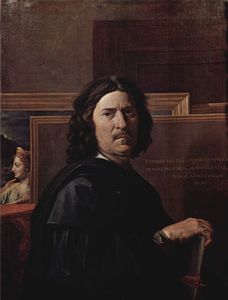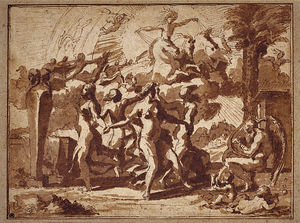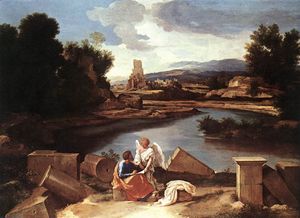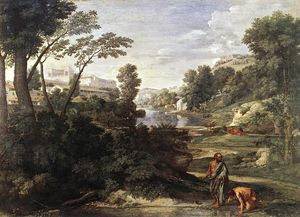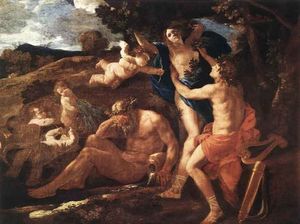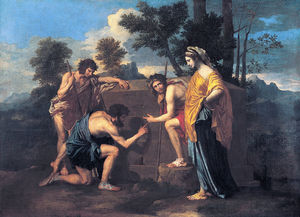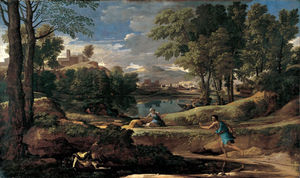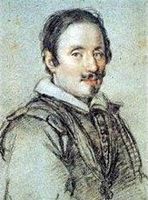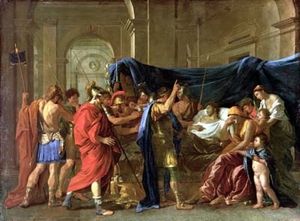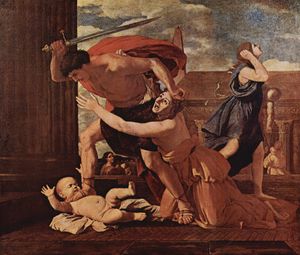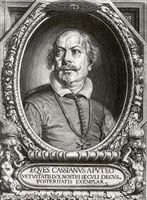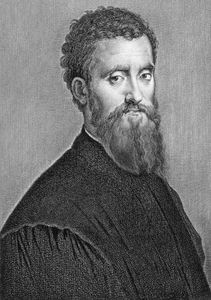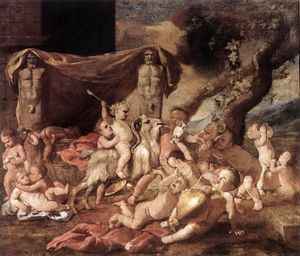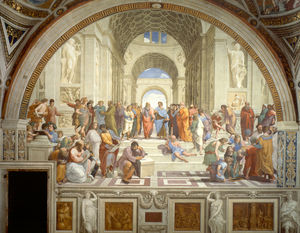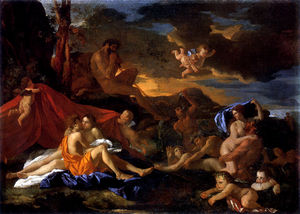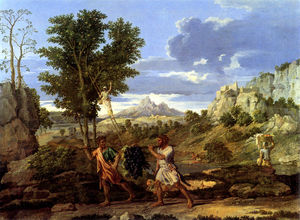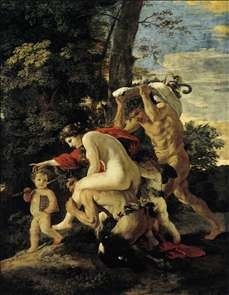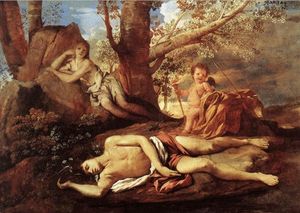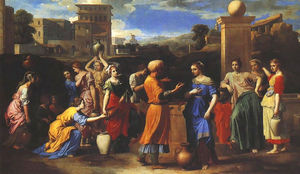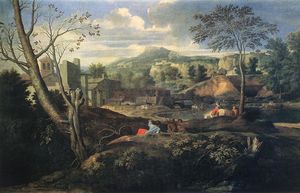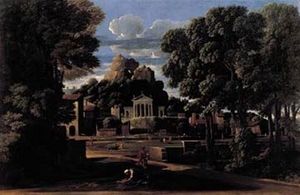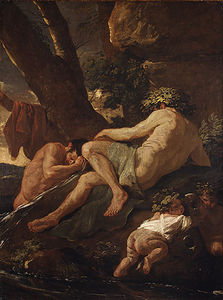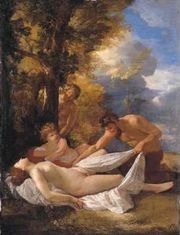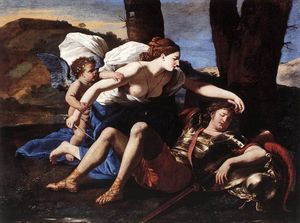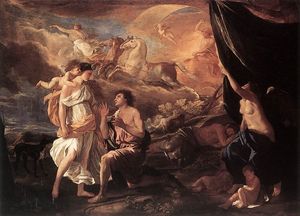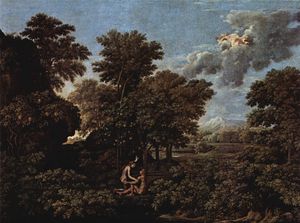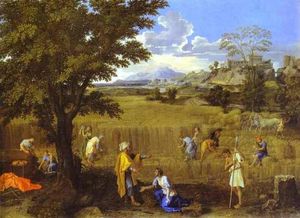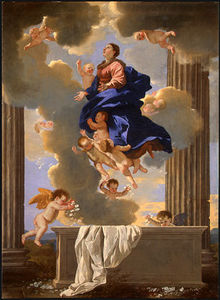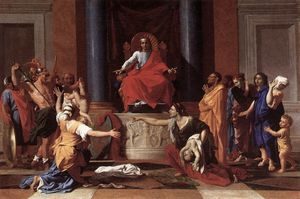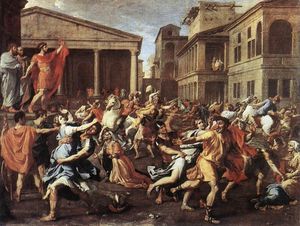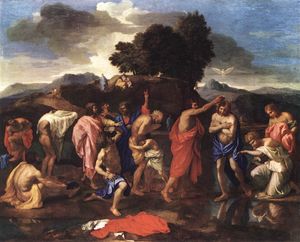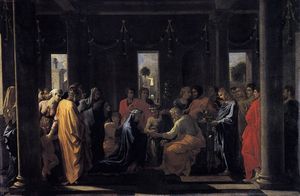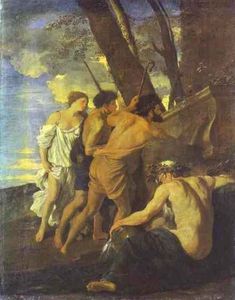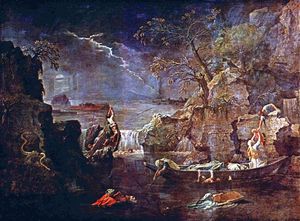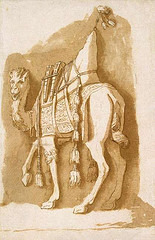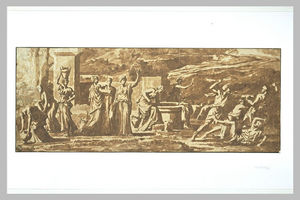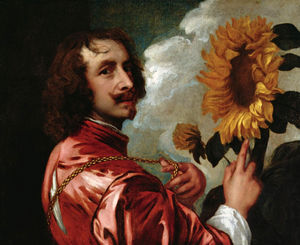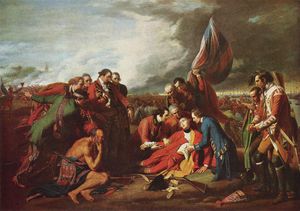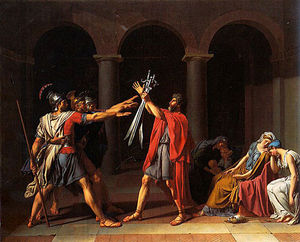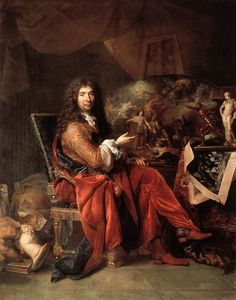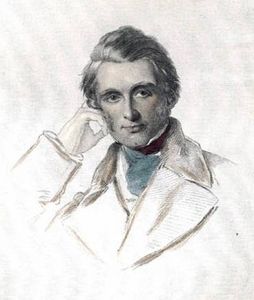Nicolas Poussin
- Short Name:
- Poussin
- Date of Birth:
- 15 Jun 1594
- Date of Death:
- 19 Nov 1665
- Focus:
- Paintings, Drawings
- Mediums:
- Oil, Other
- Subjects:
- Figure, Landscapes, Scenery
- Art Movement:
- Baroque
- Hometown:
- Les Andelys, France
Introduction
The enormously influential and often reviled painter Nicolas Poussin is, like most artists, rather misunderstood. Poussin tends to be either over-idealized by his admirers as the epitome of French Baroque painting, or dismissed by his many haters as cold and overly-intellectual. In reality, however, Poussin falls somewhere in the middle: he was neither the symbol of 17th century French painting and painter of the establishment, nor was he completely devoid of Baroque dynamism and emotion.
Poussin himself would hardly have cared whether or not he was adored or reviled. This artist, a fervent believer in Stoicism, appears to have been interested in little more than his studies and his painting; fame and wealth were but mere secondary concerns. Poussin's sober personality and his carefully thought out theories of art have earned him the nickname of "the philosopher painter."
Consequently, Poussin is regarded as the least popular of the Old Masters. Unlike other Baroque painters like Velázquez, Caravaggio, or Rubens, exhibitions of Poussin's paintings do not attract huge crowds of admiring fans. Poussin's reputation as a cold, cerebral artist of the intellect, is certainly deserved, but only to a point: as classically detached and coolly rational as Poussin's paintings may be, a closer look at this French Baroque artist's oeuvre reveals that they are also so much more.
As well as a painter, Poussin was a prodigious draftsman, but his drawing techniques differ vastly from those of his contemporaries. While other Baroque artists would execute carefully detailed finished studies for their final paintings as a kind of blueprint for the workshop assistants who would then transfer these designs onto the canvas, Poussin would do no such thing.
Poussin was fiercely possessive of his art and depended less on assistants than perhaps any other artist of his time; furthermore, he believed that the act of transferring the drawing onto the canvas was as fundamental a part of the act of creation as painting itself. Therefore, Poussin's drawings are rarely finished, polished studies but instead the mad scribblings of an artist who would obsessively draw the same composition over and over with infinite variations in arrangement.
Poussin, who was a pioneer of landscape painting along with Annibale Carracci and Claude Lorrain, also enjoyed roaming the Roman countryside and sketching what he saw. These landscape sketches are amongst the most interesting drawings in his oeuvre.
Nicolas Poussin Artistic Context
Technically, Poussin is one of the major painters of the French Baroque. In reality, however, the artist spent almost his entire career living and working in Rome, and could thus be considered as much an Italian painter as a French painter. Poussin may have lived in a different country, however, but the impact of his art back home cannot be overestimated.
Poussin's style became the official style at the French Academy in Paris for the rest of the 17th century, and Poussin's paintings were much admired by France's top historical figures, like King Louis XIII, Cardinal Richelieu, King Louis XIV, and his ministers Colbert and Le Brun. Thus, even if Poussin wasn't living and working in the heart of the French Baroque, he did have a profound influence on the molding of its style and concerns.
Although he lived in Rome for most of his adult life, Poussin was not immune to current events in his motherland: Poussin's correspondence reveals that the civil war of the mid 1640s was extremely upsetting for the artist.
Poussin's paintings evidence a veritable mix of influences, from classical antiquity and Mannerism to the Renaissance. Poussin was always able to perfectly blend these various influences, however, creating harmonious, homogenous compositions. The subjects of Poussin's paintings are rather limited in comparison to contemporary painters in Spain, Italy, or northern Europe.
Unlike many of these Baroque artists, Poussin refused to paint genre scenes. For Poussin, the only subjects worthy of being painted were grand, epic stories from history: his paintings tell the stories of ancient mythology and early Christianity with a classical poise and heroism that perfectly suits his subject.
Poussin's paintings were often inspired by relatively erudite texts and philosophies, and several of his masterpieces (like The Arcadian Shepherds and Dance to the Music of Time) continue to puzzle art historians today. In addition to these mythological and religious scenes, Poussin was also a pioneer of landscape painting, and these idealized, classical images are amongst the most important examples of this genre from the entire 17th century.
Nicolas Poussin Biography
Early Years:
Nicolas Poussin was born in Les Andelys on June 15, 1594 and showed a talent for drawing early on. Aged 17, Poussin left Normandy for bigger and better things, namely the bustling metropolis of Paris. There he had the opportunity to study masterpieces of Mannerist art by the school of Fontainbleau and Giulio Romano, which proved to be quite influential on his early style.
One of his first commissions caught the eye of Italy's most famous 17th century poet, Giambattista Marino who later brought Poussin to Rome, an obligatory trip for all European artists of the time.
Poussin's early years in Italy were even harder than his youthful days in Paris. Marino left Rome for Naples and passed away soon after, leaving his protégé alone. Luckily, before he left Marino had introduced Poussin to some of Rome's most important figures, including Cardinal Francesco Barberini. Poussin slowly began to win the respect of Rome's top patrons, and perhaps most importantly was introduced to the circle of Cassiano dal Pozzo who introduced Poussin to the antique art, philosophy, and literature which would profoundly affect the course of the French artist's painting.
Middle years:
In the late 1629s, after a particularly nasty bought with his syphilis, the artist was taken in by the Dughet family. Father Jacques was a pastry chef, and daughter Anne-Marie would become Mrs. Nicolas Poussin in 1630. This happy marriage was preceded by Poussin's first major successes as a painter: The Death of Germanicus in 1628, and Massacre of the Innocents shortly thereafter.
Poussin's success continued through the 1630s, to the point that Cardinal Richelieu back in France ordered a series of Bacchanals from the French-born artist. These paintings were so popular, King Louis XIII decided that he must have Poussin decorate the Grand-Galerie at the Louvre, and "invited" (that is to say, forced) Poussin to come back to Paris.
Advanced years:
Poussin detested large-scale, public commissions, and was absolutely miserable with his work at the Louvre. Poussin ran back to Rome in 1642 under the pretext of having to go fetch his wife, and never came back.
By the 1650s, Poussin's syphilis was so bad that his arms were extremely weak and his hands shaky, and he had great difficulty painting. His wife passed away in 1665, and Poussin was devastated by the loss. After decades of terrible pain and suffering Poussin passed away on November 19, 1665.
Nicolas Poussin Style and Technique
Contemporary viewers often reproach Poussin for his style. It seems so cold and stiff, worlds away from the vivacious drama and breathtaking naturalism that characterized the style of other Baroque artists like Caravaggio or Ribera. Making an effort to try to understand Poussin's style is well worth the effort, however.
Poussin obsessively planned every element of his style, from contour lines to colors, often using ancient art and philosophy as his inspiration; the amount of thinking and theory that informs Poussin's paintings is truly impressive.
Poussin's style is characterized by an emphasis on linearity and contours; color schemes specifically designed to suit the theme of the picture (warm, earthy tones dominate in the earlier pictures, while blues, greens and reds dominate in the mature period); strong classicizing (figures often look like ancient Greco-Roman statues), and well-developed, theatre-like space.
Being in Rome had a major impact on Poussin. This famous painter of the French Baroque wasn't just influenced by the omnipresent relics of antique art and architecture, but also by classical texts, philosophy, and literature, to which he was introduced by close friend and patron Cassiano del Pozzo.
While other artists invested a great deal of time and energy into oil sketches and cartoons, letting their assistants take over much of the actual painting, Poussin was totally different. The original control freak, he despised letting other artists help him with his work, and never had the giant factory-type workshops of other Baroque artists like Rubens or Ribera. Thus, Poussin's style is utterly distinct in Baroque art and was enormously influential for the future of Western art.
Who or What Influenced Nicolas Poussin
The following artists or ideas had the most powerful impact on Poussin;
Mannerism:
In his early years studying in Paris, Poussin studied Mannerist paintings by France's own Ecole de Fontainbleau and the Italian artist Giulio Romano. Although this movement was much derided during the 17th century, Poussin admired these often strange, esoteric masterpieces, and some of his early paintings from the 1620s evidence a Mannerist elongation of forms, complex composition, and bright, contrasting colors.
The Venetian Renaissance:
In his early career, Poussin absolutely adored the masters of the Venetian Renaissance, especially Giovanni Bellini and his most famous pupil, Titian. Poussin would have had the opportunity to see paintings by these masters during his two youthful trips to Italy before his definitive move to Rome in 1624. Poussin was particularly influenced by the Venetians' warm, sensual colors, rich, golden light, and bold, expressive brushstroke.
Although his mature oeuvre bears little witness to that fact, in his early career Poussin's paintings really do reveal this influence, as he too employed earthy, flesh-toned colors and warm rich light.
Raphael:
Poussin admired the older master for his classical forms and harmoniously balanced compositions, which were free from the chaotic emotion of contemporary painting. Works such as Raphael's School of Athens were particularly influential; Poussin returned to this painting again and again as an inspiration for particularly complex, multi-figure compositions.
Greco-Roman Antiquity:
Perhaps the most important influence on Poussin's oeuvre was the abundance of Greco-Roman antiquities virtually on every street corner in Rome. After arriving in this artistic Mecca in the 1620s, Poussin was engaged in measuring and sketching antiquities for his patron Cassiano del Pozzo's "Paper Museum. "
Many art historians have noted in particular the influence of Greco-Roman sarcophagi friezes on Poussin's works. From these classical works, Poussin took such elements as classical restrain, harmony and balance, frozen, rhetorical gestures, and hard, well-defined contour lines. Poussin also often employed the practice of radically pushing his figures in the foreground of a painting, creating a kind of wall of bodies undeniably evocative of one of these sarcophagi friezes.
Ancient Philosophy and Literature:
Some of the most important influences in the development of Poussin's style were not paintings or sculptures, but poems, plays, theories and ideas. Poussin was a devote scholar and possessed an impressive library; his biographers describe the artist as leading a quiet life of study and contemplation.
Ancient music theory, the science of optics, the philosophy of the Stoics all had an important influence on Poussin's theory of painting, and on his choice of subject and style.
Nicolas Poussin Works
Nicolas Poussin Followers
The major artists of the Baroque introduced various important stylistic elements to the history of art: Annibale Carracci and Caravaggio introduced revolutionary naturalism, Rubens and van Dyck introduced Baroque dynamism and energy, and Poussin introduced rational, classical balance and harmony.
All of these artists proved enormously influential for centuries to come, but at least in France and England, Poussin's style reigned supreme during the 18th century. Poussin may have had no formal students or apprentices, but the coming generations of young artists who studied his style would produce some of the 18th and 19th centuries' greatest painters.
Benjamin West:
The major American painter of the 18th century, West studied in Italy and England, where he may have had the opportunity to study some of Poussin's paintings. West was a master of Neoclassicism, and painted in the same restrained, classicizing style as Poussin, the major source of inspiration for this artistic movement. West described his style as "epic representation," and his most famous painting, The Death of General Wolfe, was largely inspired by Poussin's work.
Jacques-Louis David:
Although he lived and worked in Italy for the most of his life, Poussin's biggest influence may have been back home in France. Poussin's style was adored my Louis XIV's ministers Colbert and le Brun, and at the end of the 17th century the French Academy was obsessed with a debate between classical, restrained "Poussinisme" and expressive, disorderly "Rubénisme. "
Ultimately, Poussin won out when David reinvented his style around the time of the French Revolution. David's Oath of the Horatii is the ultimate example of David's early, classicizing, Poussinesque style.
Paul Cézanne:
Poussin was one of the major inspirations for this Post-Impressionist painter, who declared that he wished to recreate Poussin "after nature. " Cézanne's style is clearly more abstract than that of his predecessor; the painter wished to paint a vision of exactly what he saw, but reduced to abstract forms and colors.
Nonetheless, Cézanne retains Poussin's classical balance and stability as well as his emphasis on rational, harmonic geometric forms. Through Cézanne, Poussin would also have an indirect impact on later artists like Picasso, who claimed Cézanne as his artistic father.
Nicolas Poussin Critical Reception
Despite being idolized during the Neoclassical period, in the nineteenth century the tide began to turn against painters of the "establishment," and Poussin was more or less despised until his reputation began to be restored in the twentieth century.
During Life:
Poussin's paintings may not have been known to a wide audience during his own lifetime, as the artist painted almost exclusively for elite, private patrons, but his art and theory of painting enjoyed undeniable popularity and had an enormous influence on art criticism of the age.
Poussin's style and theories on painting would come to be artistic dogma in the second half of the century, when Charles le Brun took Poussin's rules for art as gospel as the director of the French Academy.
During this period, a fierce debate arose between the "Poussinistes" and the "Rubenistes," or those who supported Poussin's classical, academic style and those who preferred the artistic freedom of an artist like Rubens. This debate would continue into the following century, as the followers of the Neoclassical style (like Ingres) battled with Romantic artists like Delacroix.
The 19th Century:
With the arrival of Romanticism things began to change. Not only was Poussin's art derided by new generations of up-and-coming artists, but art critics began to turn against it as well. Most notorious amongst these critics was John Ruskin, who seemed to praise homegrown artists of the Pre-Raphaelite movement at the expense of all else.
For Ruskin, Poussin had foolishly abided by the study of antiquities and theory and thus failed to study for nature, and furthermore Ruskin absolutely abhorred the classical landscape.
The very end of the century started to see a turn in opinion as avant-garde Post-Impressionist painter Paul Cézanne was unequivocally a fan of Poussin and greatly inspired the modern artist in many of his abstract compositions.
The 20th Century:
Poussin's reputation began to be restored in the 20th century. Anthony Blunt, that notorious Soviet spy-cum-art historian, is widely regarded as the preeminent Poussin expert of the century, and is the author of the definitive tomes on the artist.
Poussin still may not be terribly popular amongst museum goers, but the artist has assuredly earned his place as one of the greatest masters in Western art.
Nicolas Poussin Bibliography
For more information about Poussin and his works please refer to the recommended reading list below.
• Bätschmann, Oskar. Nicolas Poussin: Dialectics of Painting. Reaktion Books, 1990
• Beresford, Richard. A Dance to the Music of Time by Nicolas Poussin. Trustees of the Wallace Collection, 1995
• Blunt, Anthony. The Paintings of Nicolas Poussin: Critical Catalogue. Phaidon, 1966
• Carrier, David. Poussin's Paintings: A Study in Art-Historical Methodology. Pennsylvania State University Press, 1993
• Cropper, Elizabeth and Charles Dempsey. Nicolas Poussin: Friendship and the Love of Painting. Princeton University Press, 1996
• Friedlaender, Walter. Nicolas Poussin, a New Approach. Abrams, 1966
• Lagerlöf, Margaretha Rossholm. Ideal Landscape: Annibale Carracci, Nicolas Poussin, and Claude Lorrain. Yale University Press, 1990
• McTighe, Sheila. Nicolas Poussin's Landscape Allegories. Cambridge University Press, 1996
• Oberhuber, Konrad. Poussin, the Early Years in Rome: the Origins of French Classicism. Hudson Hills Press, 1988
• Olson, Todd. Poussin and France: Painting, Humanism, and the Politics of Style. Yale University Press, 2002

